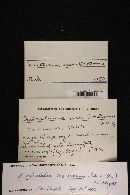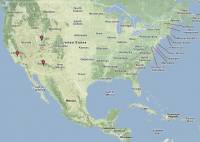
|
|
|
|
Family: Agaricaceae
|
Wright J.E. 1987. Bibliotheca Mycologia 113: 154. Tulostoma meristostoma Long (Fig.98; Pls. XXIV: 8; XLVIII:1) - Mycologia 36: 333-337, fig. 6. 1944. Etym.: The name refers to the slit mouth often appearing in specimens. Spore-sac up to 22 mm diam, globose to depressed-globose, the usual measure being 8-10 mm. Exoperidium hyphal, mixed with sand particles, slowly deciduous. Endoperidium chalky white to whitish ochre, subsmooth or with scars of sand grains. Mouth indefinite, plane, irregularly lacerate. Socket very distinct, separated from stem, with a ring-like membrane. Gleba dark ferrugineous to tobacco or chocolate colour. Stem up to 80 mm 1-ong by 5-10 mm thick, attenuated towards the base or the apex, or both; at the base it exhibits a volviform structure with a radicating base, sometimes very pronounced, or thick rhizomorphs; longitudinally striate, particularly in the upper fourth, straw-colour to crem-whitish, in some specimens parasitized by micromycetes, decorticating irregularly. Endoperidium formed by hyaline threads with scarce lumen, not distinctly swollen at the frequent septa, or by ribbon-like hyphae with blunt ends and common transverse septa. Spores subglobose to irregularly elliptic, coloured, smooth, episporium thick, vacuolate and apiculate under L.M.; under SEM they appear with some very minute, isolated warts, and the walls very minutely cracked; 4-7.4 µm diam., the usual size being 5-6 µm; the most elliptic ones measure 3.6-4.8 x 4.8-5.7 um. Capillitium coloured, thin to thick-walled, branched, with numerous blind ends or short arms, lumen visible, septa scant or absent, 3.3-9.6 µm diam, possibly early disjointable. Habitat: typically in sandy soils in arid and gravelly sites, isolated. Distribution: North America: United States; South America: Argentina. Holotype: United States: New Mexico, Albuquerque, Sandia Plaza (Herb. Long n° 10.392, BPI!). Illustration: Long (op.cit.). |



















